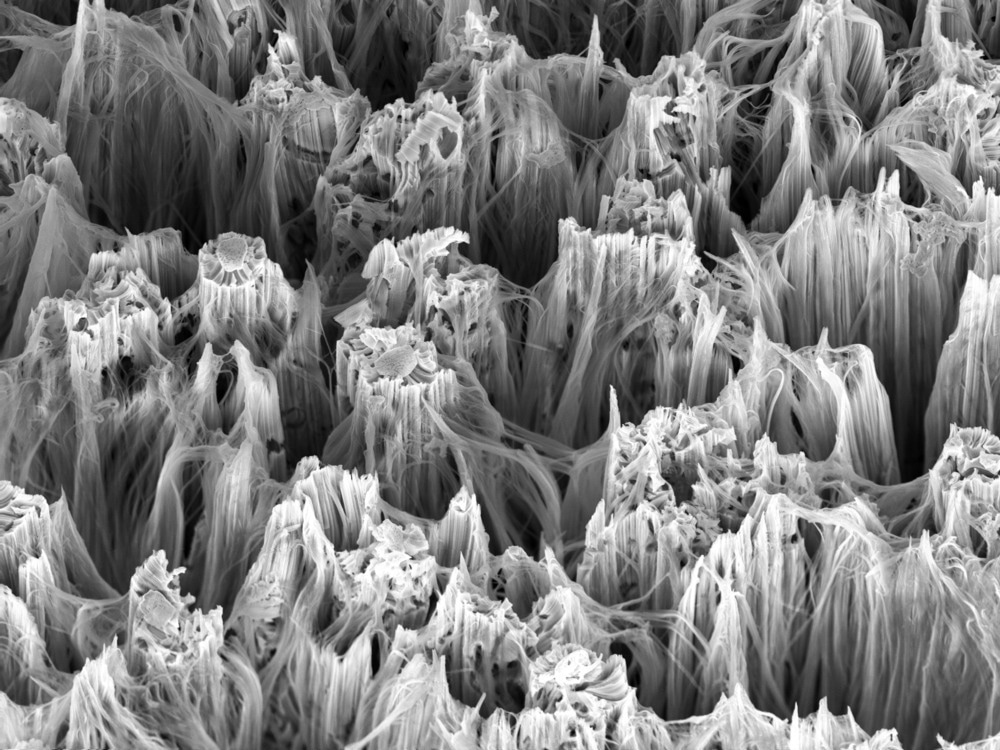Energy harvesting (EH) converts natural or waste energy (such as heat losses, vibrations, light, and air flows) into usable energy. A paper published in the journal Materials investigates the piezoelectric behavior of ZnO nanowires with mechanical actuation.

Study: Piezoelectric Response and Substrate Effect of ZnO Nanowires for Mechanical Energy Harvesting in Internet-of-Things Applications. Image Credit: Roberto Lo Savio/Shutterstock.com
Internet-of-Things – The Future of Technological Applications
The concept of internet-of-things (IoT) is being realized as an increasing number of tangible devices are linked with the Internet.
The internet-of-things allows physical things to exchange data and make decisions, removing the need for human intervention.
Internet-of-things applications include industrial automation, sensors, healthcare, transportation, and emergency responses to natural and anthropogenic catastrophes.
Current Challenges Faced by Internet-of-Things
Current difficulties faced by the internet-of-things include device sizes, mobility, deployment sites, and number, as well as power sources for all the internet-of-things device nodes.
The traditional power sources (batteries or cables) have significant limitations. Batteries must be checked regularly and, if necessary, replaced.
This necessitates physical accessibility to all the IoT nodes. Batteries negatively influence the ecosystem due to masses of used-battery garbage. Wire supply is also costly and difficult to alter, limiting the mobility and portability of the devices connected by the IoT.
As a result, energy independence would be a great relief for IoT, opening the door for future industry expansion and growth.
What is Energy Harvesting?
The rise of the internet-of-things market and the creation of less energy-intensive gadgets are pushing research into alternate power supply, which enables cable and battery removal.
Microscale and nanoscale technology advancement has created new opportunities to produce adequate energy from natural or waste sources. This method defines energy harvesting (EH).
Various energy sources need a customized energy harvesting methodology. Different physical phenomena and topologies may generate varying quantities of electricity.
When power densities in the μW or mW range are compared to the power required to supply contemporary electronic equipment or modern internet-of-things nodes, a well-chosen energy harvesting generator may completely meet the supply needs of a modern internet-of-things node, producing energy-autonomous equipment.
The Role of Piezoelectric ZnO Nanowires
Piezoelectricity converts mechanical vibrations directly into electricity in a single step. Therefore, the piezoelectric material is an essential part of this energy conversion.
Zinc oxide (ZnO), which is made of non-toxic and abundant elements, is a highly researched piezoelectric material. The possibility of synthesizing ZnO nanowires that boost the piezoelectric behavior in the chosen axis is particularly noteworthy.
The orientation of ZnO nanowires is heavily influenced by the substrate on which they are produced.
Results of the Study
In this study, the team showed the formation of ZnO nanowires using a chemical bath on a unique substrate – AISI 301 steel.
Mechanical EH applications were the key consideration when selecting the substrate. The recorded voltage with repetitive mechanical actuation after the deposition of ZnO nanowires provided a mechanism for confirming the applicability of ZnO nanowires in internet-of-things technologies.
The nanoscale active layer of ZnO nanowires was applied directly onto the substrate, which had been prepared first by a seeding procedure via the atomic layer deposition (ALD) of thin oxides.
A standard approach wherein pure ZnO is employed as a seed layer to accelerate nanowire formation was adjusted to accommodate the AISI 301 steel's specific surface features.
The ZnO seed layer was modified by adding a 20 nanometer-thick layer of an additional oxide – Al2O3. This additional oxide layer helped to alleviate the ZnO ALD layer's adhesive difficulties.
The observed voltage signal remained steady after hundreds of actuations for every specimen, proving the piezoelectric layer's resistance to persistent mechanical stress.
The piezoelectric layer provided significant power, sufficient for ordinary internet-of-things device activities. The power density was comparable to ZnO nanowires grown on a different kind of flexible substrate.
These findings showed great potential for using ZnO nanowires to generate power for an internet-of-things wireless sensor node. The suggested manufacturing process for ZnO nanowires was cost-effective and readily scalable.
Reference
Wlazło, M., Haras, M. et al. (2022) Piezoelectric Response and Substrate Effect of ZnO Nanowires for Mechanical Energy Harvesting in Internet-of-Things Applications. Materials. 15. Available at: https://www.mdpi.com/1996-1944/15/19/6767
Disclaimer: The views expressed here are those of the author expressed in their private capacity and do not necessarily represent the views of AZoM.com Limited T/A AZoNetwork the owner and operator of this website. This disclaimer forms part of the Terms and conditions of use of this website.